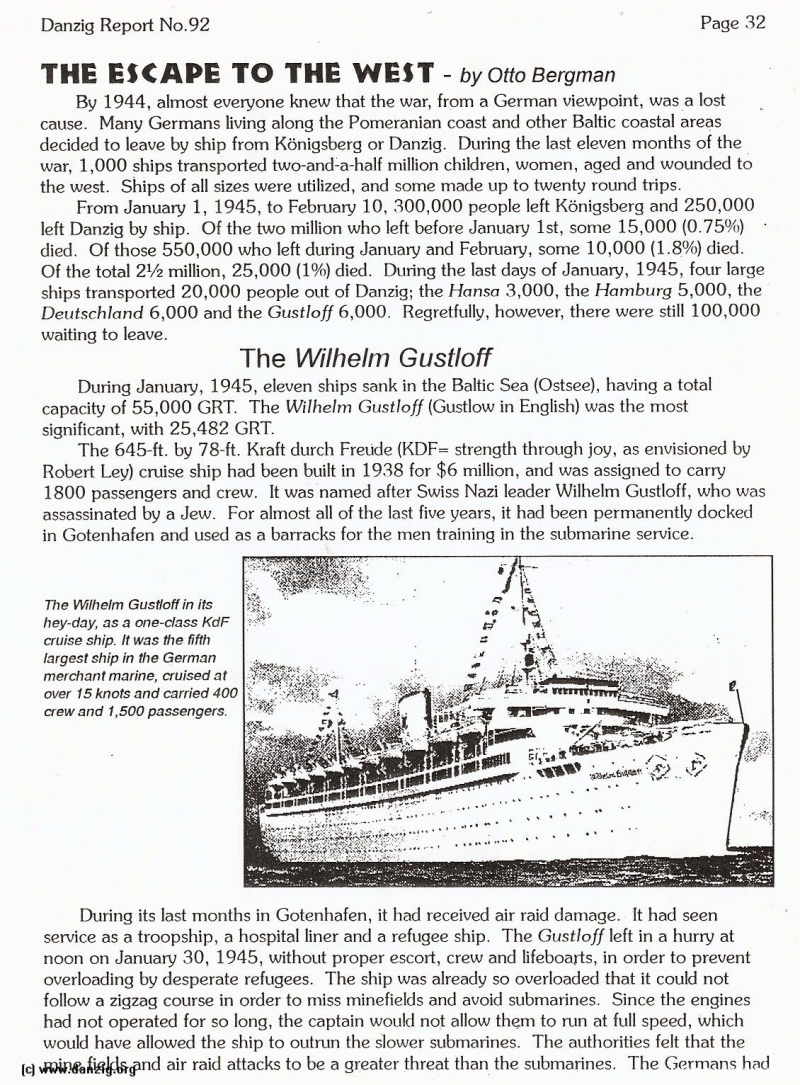
THE ESCAPE TO THE WEST - by Otto Bergman
By 1944, almost everyone knew that the war, from a German viewpoint, was a lost cause. Many Germans living along the Pomeranian coast and other Baltic coastal areas decided to leave by ship from Konigsberg or Danzig. During the last eleven months of the war, 1,000 ships transported two-and-a-half million children, women, aged and wounded to the west. Ships of all sizes were utilized, and some made up to twenty round trips.
From January 1, 1945, to February 10, 300,000 people left Konigsberg and 250,000 left Danzig by ship. Of the two million who left before January 1st, some 15,000 (0.75%) died. Of those 550,000 who left during January and February, some 10,000 (1 .8°A) died. Of the total 2/2 million, 25,000 (1°A’) died. During the last days of January, 1945, four large ships transported 20,000 people out of Danzig; the Hansa 3,000, the Hamburg 5,000, the Deutschland 6,000 and the Gustloff 6,000. Regretfully, however, there were still 100,000 waiting to leave.
The Wilhelm Gustloff
During January, 1945, eleven ships sank in the Baltic Sea (Ostsee), having a total capacity of 55,000 GRT. The Wilhelm Gustloff (Gustlow in English) was the most significant, with 25,482 GRT.
The 645-ft. by 78-ft. Kraft durch Freude (KDF= strength through joy, as envisioned by Robert Ley) cruise ship had been built in 1938 for $6 million, and was assigned to carry 1800 passengers and crew. It was named after Swiss Nazi leader Wilhelm Gustloff, who was assassinated by a Jew. For almost all of the last five years, it had been permanently docked in Gotenhafen and used as a barracks for the men training in the submarine service.
The Wilhelm Gustloff in its hey-day, as a one-class KdF cruise ship. It was the fifth largest ship in the German merchant marine, cruised at over 15 knots and carried 400 crew and 1,500 passengers.
During its last months in Gotenhafen, it had received air raid damage. It had seen service as a troopship, a hospital liner and a refugee ship. The Gustloff left in a hurry at noon on January 30, 1945, without proper escort, crew and lifeboarts, in order to prevent overloading by desperate refugees. The ship was already so overloaded that it could not follow a zigzag course in order to miss minefields and avoid submarines. Since the engines had not operated for so long, the captain would not allow them to run at full speed, which would have allowed the ship to outrun the slower submarines. The authorities felt that the mine fields and air raid attacks to be a greater threat than the submarines. The Germans had
Danzig Report Vol. 1 - Nr. 92 - July - August - September - 1996, Page 32.
Hits: 1655
Added: 18/07/2015
Copyright: 2024 Danzig.org

